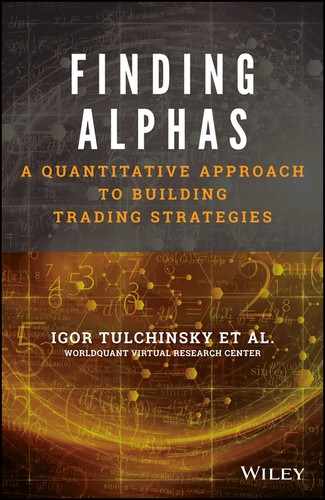8
Equity Price and Volume
By Cong Li
In finance, the efficient-market hypothesis (EMH) asserts that financial markets are “information efficient.” As a result, with the information available at the time when the investment is made, one cannot consistently achieve returns in excess of average market returns on a risk-adjusted basis.
There are three major versions of EMH: the “weak,” the “semi-strong,” and the “strong.” The “weak” hypothesis states that prices on traded assets (e.g. stocks, bonds, or property) already reflect all past available public information; the “semi-strong” hypothesis claims that all past publicly available information and current public information is already priced into securities; and the “strong” hypothesis states that all public information, and even private information, is reflected in a security’s price. Thus, given only the current and historical price/volume data, the belief is that we can’t realize any profit in an efficient market, and that there are no such things as “price/volume alphas.”
Is this true? No, it is not. Actually, with the development of information technology, information processing, automatic trading, etc., the market is already close to, but never at, full efficiency. Quantitative traders seek to profit from those inefficiencies.
Just how can we arbitrage from these inefficiencies?
Information ratio (IR) (defined as mean [daily_pnl]/std[daily_pnl], a measure of the risk-adjusted return of a financial security, or a portfolio) is proportional to the square root of asset number we trade: IR = IC * sqrt(breadth), and it means that, given the same IC (information coefficient, defined as the correlation of predicted return and realized return), we believe better risk-adjusted profit can be achieved.
Unlike some long-term investors who balance their position once a quarter, active portfolio managers typically trade more frequently. They rebalance their portfolio daily, in multiple times. The more often they trade, the more likely the statistical metrics will show. When we add N Gaussian or normal distributions, the common occurring continuous probability distributions that tell the probability that any real observation will fall between any two real limits, and which are independent and identically distributed, the result yields to the same mean but 1/sqrt(N) standard deviation compared to the original distribution. Given the same IC, traded four more times, we can expect two times better IR.
If we look at it from a different angle, given a large pool of assets traded, it’s possible to treat them as a whole instead of as individual stocks. If we look at a single instrument, we can see technical indicators like moving average convergence divergence, which is the momentum indicator that shows the relationship between two moving averages of prices, or average true range, which is a measure of volatility that is a moving average over the course of 14 days – generally. When we look at a portfolio, we see different things, such as inner relationships of the instruments, the co-movement as a group, and the relatively different yet weird behavior of a stock as compared with that of others. By looking at the whole group, global optimization and group risk neutralization can be achieved.
Most importantly, we should trade with models others don’t have. In this industry, each trader cherishes his or her models very much and keeps them well hidden. A model is valuable only when it has limited exposure. Once it becomes public, the model’s predictive power diminishes, and will soon disappear for good. The market is also evolving; the old models decay as the new ones emerge. Consistently looking for new models is the key to why some firms can survive in this business. The models and ideas come from everywhere: they can be inspired by some academic paper, can be our insights on the market, or a flashing thought when you are taking a shower. The micro-structure of the stock price is interesting. That makes us ask: based on what condition does this stock tend to go up or down, and what are the factors that would affect the stock’s future trend, momentum or reverse? There are many tools to utilize: math and statistics are well known in the equity trading market; pattern recognition and signal processing tools have also been introduced in recent years, which show that there are many ways that simple equity price and volume data can be used in quantitative finance.
